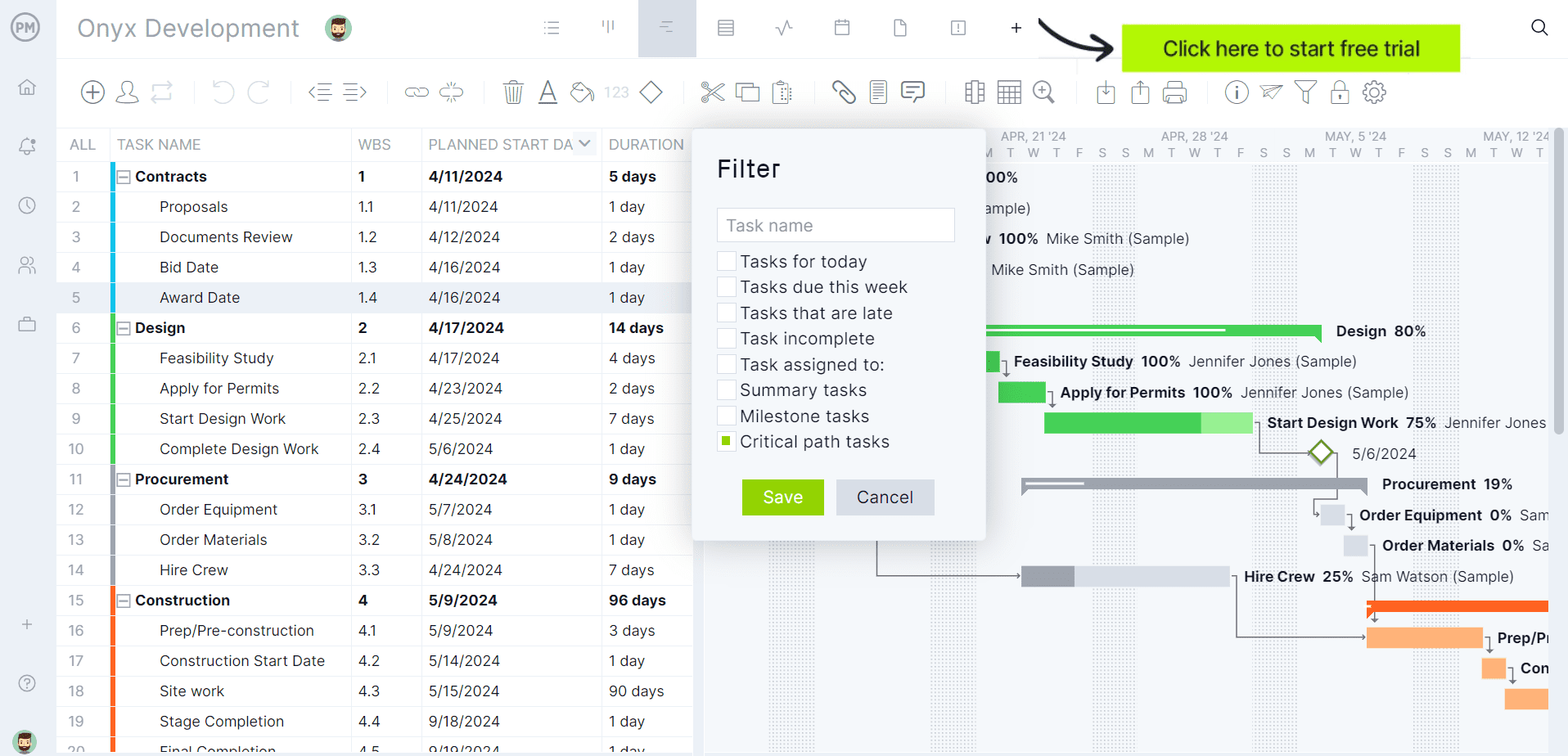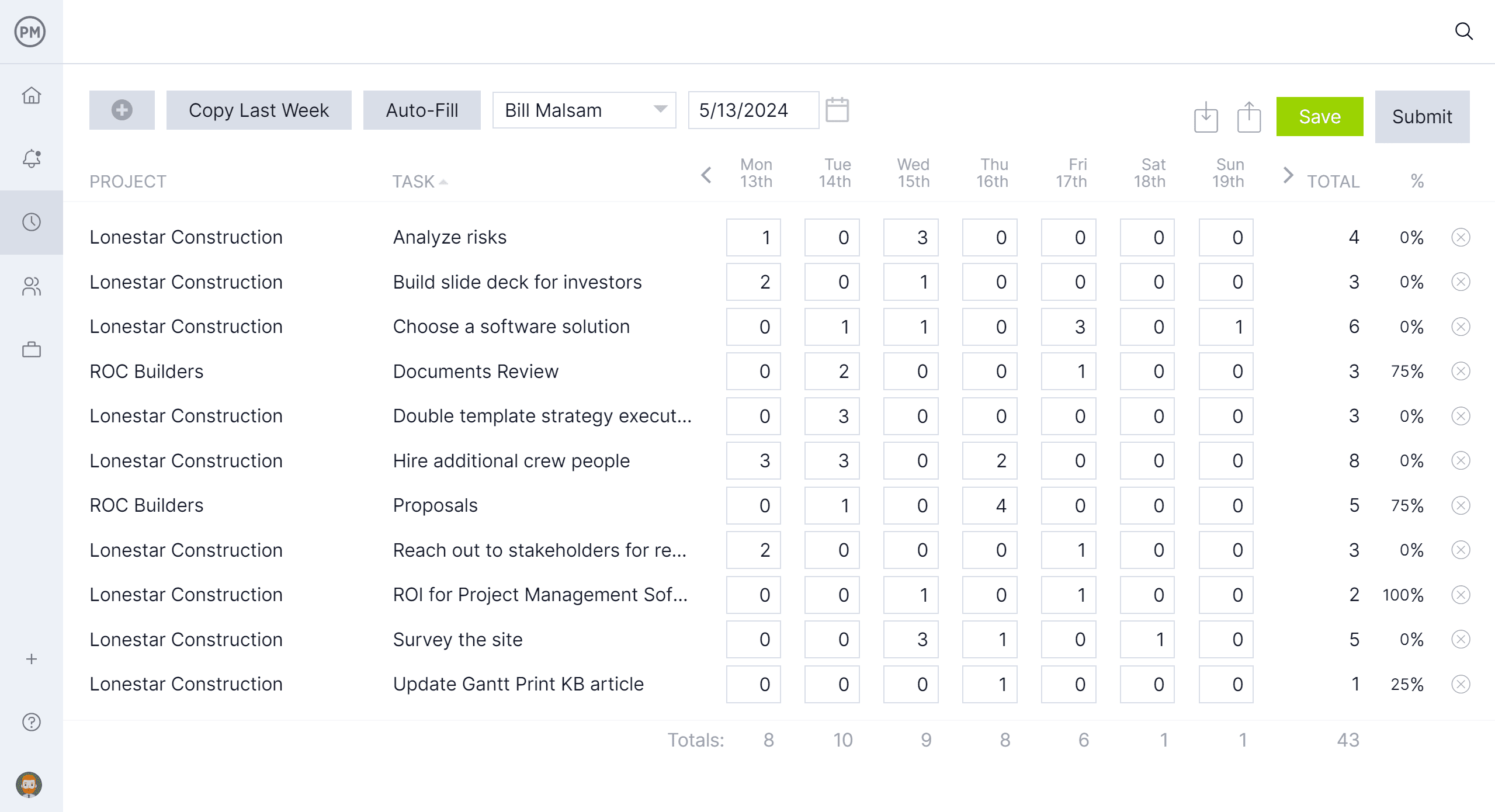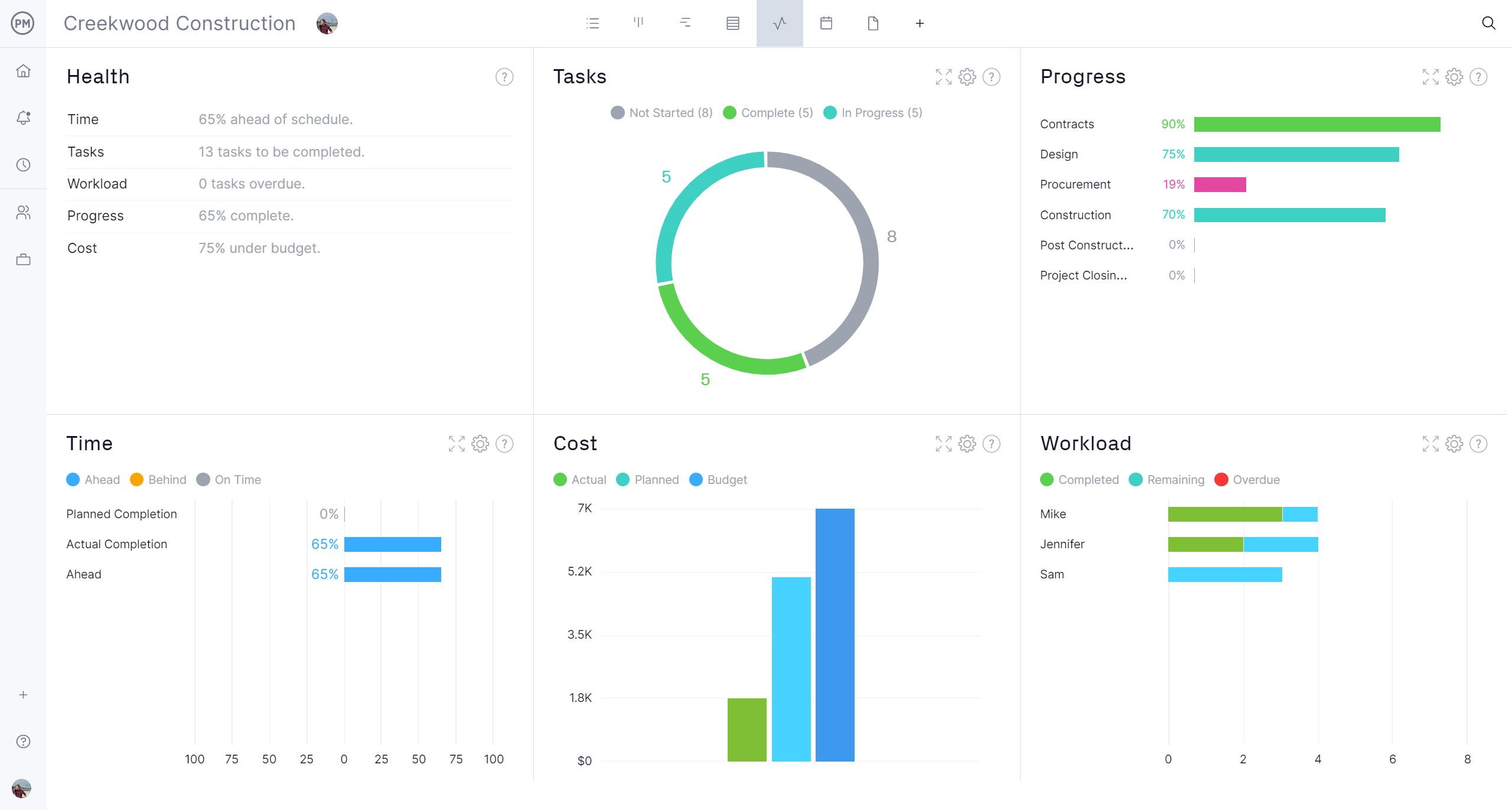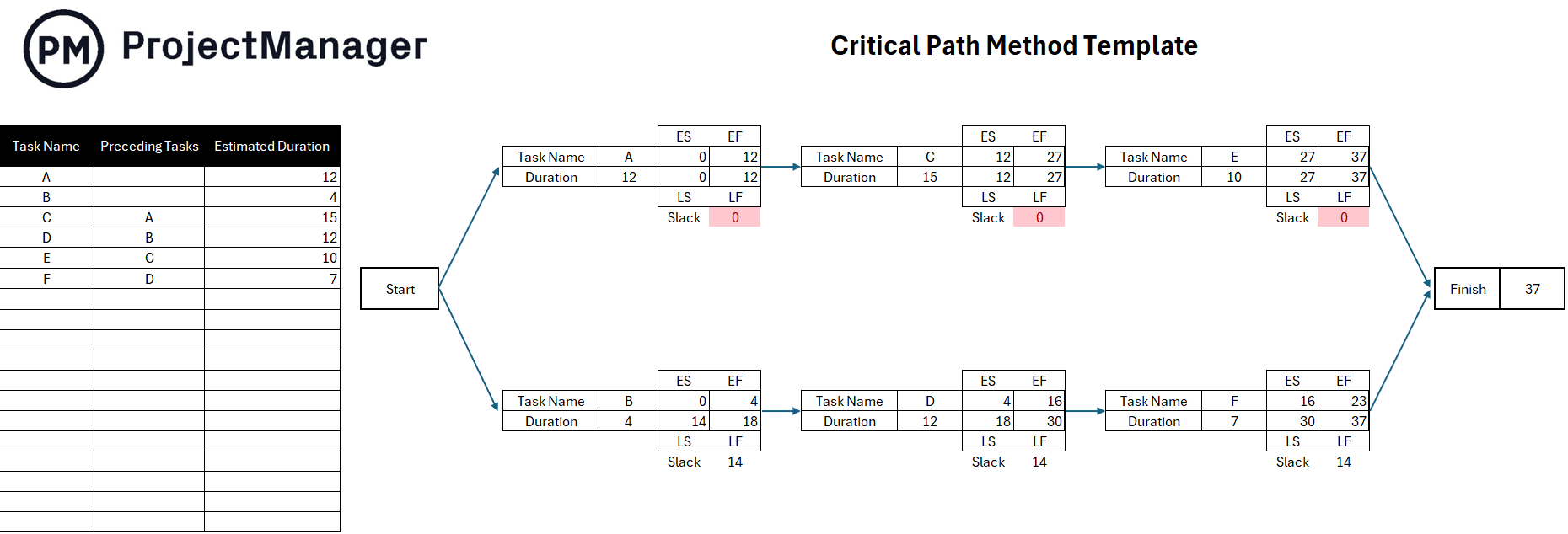Construction projects are notoriously difficult. They involve multiple teams, suppliers and more when building a structure. Ensuring the schedule is realistic and the project can be delivered on time requires techniques such as CPM construction.
What is CPM construction? It stands for the critical path method in construction. What is critical path construction? That’s what we’ll learn, including how to make a CPM construction schedule and why general contractors want to use it. We’ll even throw in a free critical path template.
What Is the Critical Path Method (CPM) in Construction?
As noted above, CPM construction stands for the critical path method. It’s a project management technique used to make a construction schedule, determine the longest sequence of dependent tasks and identify the shortest possible duration for completing the project.
Using CPM in construction helps project managers prioritize tasks, allocate resources effectively and identify potential delays. This is crucial for keeping projects on schedule, optimizing resource allocation and minimizing delays or cost overruns.
Two key elements of CPM construction are the critical path diagram and the critical path algorithm. They help visualize and calculate the project schedule. Let’s look at both of these elements to better understand them.
- Critical Path Diagram: This visually represents the project’s activities, dependencies and the sequence in which tasks must be completed. It helps identify the project’s critical path.
- Critical Path Algorithm: This is used to calculate the critical path and project schedule. It is typically performed using one of two methods: forward pass and backward pass. The algorithm helps determine the project’s duration, identify critical tasks and calculate float or slack time (the amount of time a specific task or activity can be delayed without negatively impacting the project’s schedule).
We’ll show how to create a CPM construction schedule by hand, but who has time for that? When managing a construction project, general contractors and their teams need to be more efficient, which is why they use construction project management software.
ProjectManager is award-winning construction project and portfolio management software with robust Gantt charts to create schedules and identify the critical path. Like any Gantt chart, ours can organize tasks and allocate resources and costs. But we go beyond that to link all four types of task dependencies to avoid delays and cost overruns and can set a baseline to track progress in real time. There’s also a filter to identify the critical path, without having to pick up pen and paper or engage in complex calculations. Get started with ProjectManager today for free.


What Is the Critical Path of a Construction Project?
The critical path of a construction project is the series of tasks that determine the earliest possible completion date for the project. As noted above, it’s the longest sequence of dependent activities, meaning these tasks are directly connected. Any delay in one of them will result in a delay in the project’s overall completion.
In simpler terms, the critical path represents the chain of activities that have no slack time. In other words, there is no room for delay in these tasks without pushing back the final project deadline. Knowing this is critical for project planning and monitoring. It helps project managers focus on the most important tasks that could impact the project’s success. By identifying the critical path, construction crews can allocate resources more effectively and complete tasks on schedule.
How to Make a CPM Construction Schedule
Creating a critical path method construction schedule involves several steps. Note, this is how one would make the CPM construction schedule with a pen and paper. The following is a detailed guide on how to do it manually.
1. Create a List of Tasks
Start by creating a comprehensive list of all tasks involved in the project. These tasks should represent the activities that need to be completed during the construction process. It’s ideal to use a work breakdown structure (WBS). This hierarchical diagram captures all the deliverables in the project and the tasks or activities needed to complete them.
2. Estimate the Duration of Tasks
For each task, estimate the duration. There are several ways to help make a more accurate forecast. For example, there’s historical data from past, similar projects. Also, seek out experts for their judgment.
3. Identify Task Dependencies
At this point, the general contractor or whoever is building the construction schedule, has to determine the tasks that are dependent on other tasks. This means that one task can’t start or end until another dependent task has been started or completed.
4. Draw a Critical Path Diagram
Now, use a piece of paper to visually represent the tasks and their dependencies in a network diagram. This is typically done using nodes, a circle to represent tasks, and arrows to show dependencies.
5. Calculate the Critical Path of the Project
To calculate the critical path and determine the longest path through the network’s diagram, one must calculate the earliest start time (ES) and earliest finish time (EF) for each task, as well as the latest start time (LS) and latest finish time (LF). Any tasks with zero float (the difference between the earliest and latest times) are on the critical path.
Critical Path Template
Finding the critical path on paper is one way to help when scheduling a CPM construction project. However, there are more efficient ways. The best is the use of construction project management software, but for those who aren’t ready to upgrade, download this free critical path template for Excel.
Use this free template during the planning phase of a CPM construction project. It helps determine a more realistic schedule that can be followed to deliver the project on time. Instead of creating a CPM construction schedule from scratch, this free template lays it all out, from ES, EF, LS, LF and slack.
Benefits of Implementing CPM in Construction Projects
Using CPM in construction projects offers several significant benefits. These advantages help improve project planning, execution and control. They help projects deliver on time and within budget. Here are a few key benefits.
Prioritizes the Allocation of Resources for Critical Tasks
One key benefit of CPM construction is that it helps project managers identify which tasks are on the critical path, meaning these tasks directly impact the project’s overall completion time. These tasks are the most important to complete on time and any delay in them will cause a delay in the entire project. The critical path does this by focusing on those critical tasks, optimizing resource use, helping with resource-leveling to balance resources across tasks, managing dependencies and minimizing delays.
Facilitates Project Task Sequencing and Workflow Management
One primary goal of CPM construction is to help project managers plan and coordinate all tasks involved in the construction process, ensuring they are completed in the right order with minimal delays. It assists in task sequencing by defining task dependencies, establishing the critical path and defining task duration.
In terms of workflow management, CPM in construction visualizes task dependencies and scheduling to see the flow of tasks and their dependencies, which makes managing the workflow easier. It minimizes downtime by making sure when one task is done, the next can start. It also optimizes resources across tasks.
Helps Accurately Track Project Progress
CPM construction is also an excellent way to accurately track project progress. It helps project managers continuously monitor the status of tasks, identify potential bottlenecks and ensure the project stays on track. Monitoring critical tasks in real time is essential for regular updates, as well as tracking milestones and identifying delays and taking corrective action. It also tracks float and slack time and can forecast project completion, which keeps stakeholders informed.
ProjectManager Is CPM Scheduling Software for Construction
All of those advantages can be achieved. Project managers might reap the benefits by creating a CPM construction schedule on paper or even the free template we offer. However, the point of using the critical path in scheduling a construction project is to work more efficiently. This requires investing in construction project management software. But not all software is equal. ProjectManager is award-winning construction project and portfolio management software with powerful Gantt charts that can make construction schedules that identify the critical path. This forecasts projects more accurately and provides tools to track project progress in real time.
Track Labor Costs With Timesheets and Workload Management Charts
Monitoring progress is important, but there’s more to time management when running a construction project. If the budget gets out of hand, general contractors can kiss their profit margin goodbye. Therefore, costs are also a critical metric to track. Secure timesheets streamline payroll and offer a window into labor costs. To keep labor working as scheduled, our resource management tools balance workload and provide a real-time overview of resource allocation with color-coded workload charts. There’s even a team page that summarizes crew activities on a daily or weekly basis. It can be filtered to view priority, progress and more.


Monitor Project Progress With Real-Time Dashboards
There are multiple ways to monitor costs and other key performance indicators (KPIs). Project managers can have a high-level view of the project by toggling to the real-time project or portfolio dashboards. These tools automatically collect live data and display them in easy-to-read graphs and charts that show time, cost, workload, health and more. It’s an instant status report. For a real status or portfolio report, as well as reports on variance, timesheets, workload and more, visit our reporting page. All reports are customizable, meaning they can be filtered to show details or provide a summary and share easily to update stakeholders.


Related CPM Construction Content
Critical path construction is important. For those who want to delve into the critical path, there’s more to learn. Below are a handful of recent articles we’ve published on CPM with Gantt charts, how to use PERT with CPM and much more.
ProjectManager is online construction project and portfolio management software that connects teams whether they’re in the office or on the job site. They can share files, comment at the task level and stay updated with email and in-app notifications. Get started with ProjectManager today for free.







